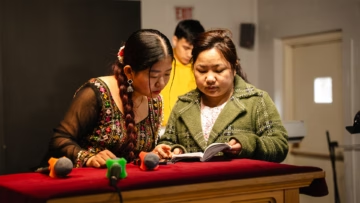
Henry Miller, an American Novelist, said, “To be silent the whole day, see no newspaper, hear no radio, listen to no gossip … to be thoroughly and completely indifferent to the fate of the world is the finest medicine a [person] can give [themselves].” This is from Miller’s 1941 travelogue and is perhaps more vividly captured in Andrew Wyeth’s 1961 Distant Thunder artwork. In the painting by Wyeth, Miller’s words are made visual. A person is lying peacefully in a wide-open field with a mug of coffee, a book, and the only living companion nearby is a yellow Labrador retriever. That painting is my scene when it comes to seeking peace. I love the coffee mug, the wide-open field, a book within reach, and the lab, my favorite dog.
Whatever our scene of peace might be, we all have one. There is some favorite location of solitude, a meditating spot at home, or a nature path where we seek peace. This kind of personal peace is something to seek and find. Besides Miller’s indifference to the world, as noted above, we see Jesus model peace-seeking in the open and quiet spaces. “But Jesus often withdrew to lonely places and prayed,” reminds the historian and gospel writer. So be it then; we are invited to be peace-seekers!
But what happens when the gospels do what they always do and call us from comfortable places? “Blessed are the peacemakers, for they will be called children of God,” says another gospel writer quoting Jesus. These two gospel verses tell a fuller story of who Jesus is and what we are called to do as his followers. We are invited to seek peace. We are called to make it as well.
When we seek peace, we may look for the open meadow, the coffee mug, and the Labrador friend. When we make peace, we open our eyes to conflicts and enter them with a specific vision: non-hostile resolution. To be a peacemaker is to move from the meadow to the mess and trust God’s grace to meet us there. Alan Kreider’s encouragement is to pour our whole selves into building a culture of peace. As we form the right culture in our lives, homes, churches, and communities, this is a witness. It tells the world that God is a God of peace, Jesus is the prince of shalom, and the Spirit’s fruit of peace can be realized.
In this critical work of peacemaking, we should not bypass the importance of perspective. Three perspectives help us as we attempt to create a culture of truer peace. These perspectives can apply to the home, workplace, family dynamics, friendships, neighborhood, or church. We could even see them applied globally and between nations in conflict. Thus, from interpersonal to international conflicts, these three perspectives help us become peacemakers in any context God leads us to and through:
Perspective 1: To be a peacemaker, we stop avoiding conflict.
To make peace, we observe conflict, note it, and consider how it impacts others. With wisdom, we approach conflict, are willing to help with reconciliation, and remind people about healthy boundaries. “But true unity should not need boundaries,” some may say. Tell my wife and me to share a closet, and we will swiftly remind you that we need certain healthy boundaries to maintain truer unity. Joking aside, boundaries matter to those within a conflict. So, to be taken seriously, we should understand and affirm others as long as they support the vision of non-hostile resolution.
Perspective 2: Conflict is an opportunity for transformation because it will end with a non-hostile and nonviolent resolution.
The peacemaker has a vision of non-hostile and nonviolent resolution. If peacemakers cannot enter a conflict with this vision in mind, I am convinced that no one else in the world can or will. The Christian believes that, because of the resurrected Christ, even conflict resolution will open redemptive and transformative paths for all involved. Our spiritual formation can flourish as we work within and for non-hostile resolution of conflict.
Perspective 3: Boundaries. Respect. Repeat.
A professor I had at Eastern Mennonite Seminary advocated for diverse congregations to unite. He believed a witness of peace in the world would be for two diverse churches to agree to come together under the vision of Galatians 3:28, which says that there are no longer divisions that define us. My professor believes these churches could be theologically, ethnically, or politically diverse and seek unity.
He asked me, “What would you do as a leader of those two diverse churches coming together?” I said, “Open the doors, start worshiping together, preach the Scriptures, and build community through grace for one another.” He said, “Wrong.” After I sat humbly in silence, he said, “Ryan, those are all good things, but you missed the most important step: Boundaries.” He said I would not get one inch towards building unity among diverse folks without healthy boundaries that are understood and respected. This is a compelling view if we truly want to enter real time conflicts as peacemakers with a vision of actual, non-hostile resolution.
After considering new perspectives and sensing the leading of the Spirit, we will find ground for building a culture of peace. It will likely not be a wide-open field with only one dog and the silence mentioned at the opening of this article. The ground may be amid a conflict, large or small. Keep looking for the ground on which to build a culture of peace.
This article was originally published in the Winter 2023 issue of SHALOM! A Journal for the Practice of Reconciliation.



